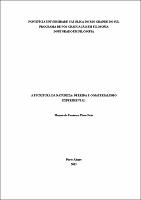| Share record |


|
Please use this identifier to cite or link to this item:
https://tede2.pucrs.br/tede2/handle/tede/2927| Document type: | Tese |
| Title: | A escritura da natureza : derrida e o materialismo experimental |
| Author: | Pinto Neto, Moysés da Fontoura  |
| Advisor: | Souza, Ricardo Timm de |
| Abstract (native): | A tese procura ler a obra de Jacques Derrida para, opondo-se à interpretação correlacionista predominante, potencializar o aspecto especulativo desse pensamento. As principais chaves de leitura são a escritura e a dyferença. Para tanto, traço uma articulação poligonal entre Derrida, Quentin Meillassoux, Sigmund Freud e Catherine Malabou, buscando reconstruir as posições do filósofo de forma afirmativa enquanto um materialismo. O efeito desse poliedro funciona por contrastes, refletindo (como um espelho invertido) sobre outros pensadores com os quais Derrida debateu ao longo da sua vida (em especial Kant, Hegel, Levinas, Husserl e Heidegger). A figura é construída em três movimentos: comparativo, estrutural e experimental. A comparação emerge a partir de uma genealogia do pensamento de Derrida a partir do que nomeio materialismo francês do século XX, procurando demonstrar que esse pensamento nunca se orientou pelas cisões kantianas entre coisa em si e fenômeno, natureza e humano, empírico e transcendental. Ele emerge em um específico contexto filósofico, científico, político e cultural que apenas recentemente vem sendo reconstituído. Tecido esse primeiro fio, passo ao argumento estrutural. A partir da crítica da ideia de totalidade (Livro), o pensamento da escritura aparece como grafemática que não se detém no interior do espaço no qual a escritura esteve confinada, pensando antes a escritura como forma sulcada do real, teoria não-hilemórfica - plástica - da forma. A essa grafemática soma-se a espectrologia, ciência do virtual que pensa o real no modo da economia geral da dyferença. Dessa economia geral inconsistente emergem economias restritas: economímesis e economia da vida_morte. Os grafemas inscrevem-se em uma superfície sem fundo, vazia e plástica, que Derrida nomeia, lembrando Platão, khora. Finalmente, o terceiro momento procura relacionar experimentalmente o pensamento de Derrida com as ciências contemporâneas (neurociências e biologia evolucionista), almejando borrar as fronteiras entre natureza, cultura e tecnologia, de um lado, e pensamento e real, de outro. A escritura e os espectros atravessam todas essas cisões em um materialismo generalizado e hiper-histórico. |
| Abstract (english): | This thesis aims to read Derrida in a way to increase the speculative aspect of his thinking, in opposition with the dominant correlationist interpretation. The main keys for this reading are writing and différance. For this task, I trace a polygonal articulation between Derrida, Quentin Meillassoux, Sigmund Freud and Catherine Malabou, trying to reconstruct the philosopher's positions in an affirmative way as materialism. The effect of this polyhedron works by contrasts, reflecting (as an inverted mirror) on other philosophers with whom Derrida debated all his life (especially Kant, Hegel, Levinas, Husserl and Heidegger). The figure is constructed in three moments: comparative, structural and experimental. The comparison emerges with a genealogy of Derrida's thinking departing from the French materialism of XXth Century, aiming to demonstrate that his thinking has never been oriented by the Kantian gaps between thing-in-itself and phenomenon, nature and culture, empirical and transcendental. It emerges in a specific philosophical, scientific, political and cultural context that is only now being reconstituted. Next step is the structural argument: departing from the critique of totality (Book), the thinking of writing appears as a graphematics that exceeds the traditional space where writing was enclosed, considering it as the facilitation (frayage) of form in the real, a non-hylomorphic (plastic) theory of form. To this graphematics is added spectrology (hauntology), virtual science that thinks reality in the general economy of différance. From this general economy, restricted economies emerge: economimesis and economy of life_death. The graphems are inscribed in a surface without ground, empty and plastic, which Derrida nominates, remembering Plato, Khora. Finally, the third moment looks to relate experimentally Derrida's thinking with contemporary sciences (neuroscience and evolutionary biology), aiming to obliterate the boundaries between nature, culture and technology, on one side, and thinking and real, on the other. Writing and specters cross all these gaps in a generalized and hyper-historical materialism. |
| Keywords: | DERRIDA, JACQUES - CRÍTICA E INTERPRETAÇÃO MATERIALISMO FILOSOFIA |
| CNPQ Knowledge Areas: | CNPQ::CIENCIAS HUMANAS::FILOSOFIA |
| Language: | por |
| Country: | BR |
| Publisher: | Pontifícia Universidade Católica do Rio Grande do Sul |
| Institution Acronym: | PUCRS |
| Department: | Faculdade de Filosofia e Ciências Humanas |
| Program: | Programa de Pós-Graduação em Filosofia |
| Citation: | PINTO NETO, Moysés da Fontoura. A escritura da natureza : derrida e o materialismo experimental. 2013. 304 f. Tese (Doutorado em Filosofia) - Pontifícia Universidade Católica do Rio Grande do Sul, Porto Alegre, 2013. |
| Access type: | Acesso Aberto |
| URI: | http://tede2.pucrs.br/tede2/handle/tede/2927 |
| Issue Date: | 18-Dec-2013 |
| Appears in Collections: | Programa de Pós-Graduação em Filosofia |
Files in This Item:
| File | Description | Size | Format | |
|---|---|---|---|---|
| 454356.pdf | Texto Completo | 2.56 MB | Adobe PDF |  Download/Open Preview |
Items in DSpace are protected by copyright, with all rights reserved, unless otherwise indicated.




